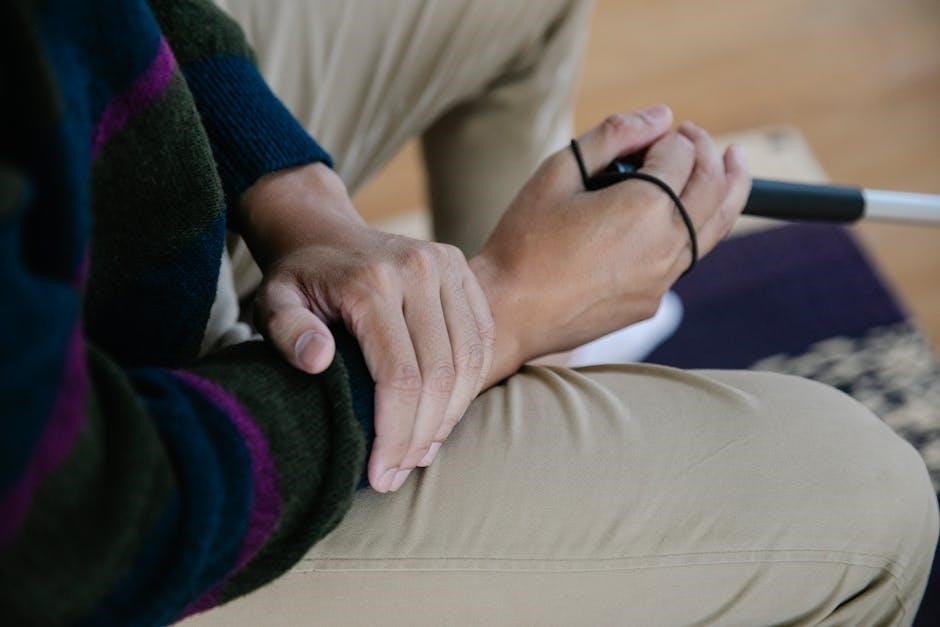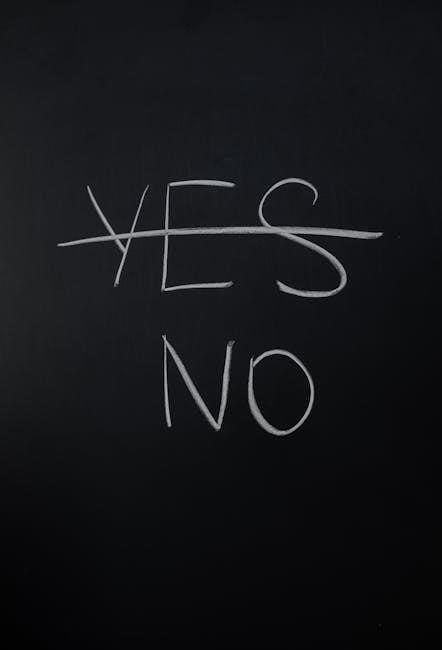internalized homophobia: a guide to overcoming shame and self-hatred
Internalized homophobia is a destructive phenomenon where individuals internalize homophobic attitudes‚ leading to self-hatred and mental health struggles. It stems from societal and cultural norms that stigmatize LGBTQ+ identities‚ causing profound emotional pain and identity conflict. Addressing this issue is crucial for personal liberation and societal change‚ as it fosters self-acceptance and challenges oppressive systems.
1.1 Definition and Understanding
Internalized homophobia refers to the process by which individuals unconsciously adopt and internalize society’s homophobic attitudes‚ leading to self-hatred and shame. It arises when people exposed to homophobic environments absorb negative messages about their sexual orientation‚ viewing themselves as flawed or unworthy. This deeply ingrained self-rejection manifests as emotional distress‚ self-loathing‚ and a struggle to accept one’s true identity. Understanding this phenomenon is crucial for addressing its harmful effects on mental health and well-being;
1.2 The Impact on Mental Health
Internalized homophobia profoundly affects mental health‚ often leading to self-hatred‚ low self-esteem‚ and emotional distress. It can manifest as anxiety‚ depression‚ or self-destructive behaviors‚ as individuals struggle to reconcile their true selves with societal expectations. This inner conflict may result in feelings of worthlessness‚ self-isolation‚ and even suicidal ideation. Addressing these mental health challenges is essential for healing and fostering a positive sense of identity and well-being.
1.3 Why It’s Important to Address
Addressing internalized homophobia is crucial for personal liberation and well-being. It allows individuals to break free from self-hatred and embrace their authentic selves‚ fostering self-acceptance and resilience. By confronting these deeply ingrained beliefs‚ individuals can heal emotionally‚ rebuild their self-esteem‚ and cultivate a positive sense of identity. This process not only benefits the individual but also challenges oppressive societal norms‚ promoting a more inclusive and accepting environment for everyone.

Causes of Internalized Homophobia
Internalized homophobia arises from the absorption of homophobic societal norms‚ often rooted in cultural‚ familial‚ and religious influences that condemn non-heterosexual identities.
2.1 Sociocultural Factors
Sociocultural factors‚ such as widespread homophobia in society‚ heteronormative norms‚ and lack of representation‚ significantly contribute to internalized homophobia. Growing up in environments where LGBTQ+ identities are stigmatized or invisible fosters self-doubt and shame. Negative media portrayal and discriminatory laws further reinforce these feelings‚ leading individuals to internalize societal hatred and struggle with self-acceptance. Addressing these factors is essential for healing and promoting inclusivity.
2.2 Family and Upbringing
Family and upbringing play a pivotal role in the development of internalized homophobia. Growing up in households with homophobic attitudes or rigid gender expectations often leads individuals to internalize negative messages about their sexual orientation. Rejection‚ conditional acceptance‚ or silence on LGBTQ+ topics can foster deep-seated shame and self-doubt. These experiences often manifest as self-hatred‚ making it difficult to embrace one’s true identity and contributing to ongoing emotional distress and confusion.
2.3 Religious and Moral Influences
Religious and moral teachings often perpetuate internalized homophobia by framing same-sex attraction as immoral or sinful. Many individuals raised in conservative religious environments internalize these beliefs‚ leading to profound guilt and self-rejection. The moral stigma imposed by religious doctrines can deepen feelings of shame and self-loathing‚ making it difficult for individuals to reconcile their sexual orientation with their spiritual or moral identity. This conflict can result in a prolonged struggle for self-acceptance and psychological well-being.

Psychological Effects of Internalized Homophobia
Internalized homophobia often leads to self-loathing‚ anxiety‚ and depression‚ as individuals struggle with societal rejection and internalized shame. It disrupts mental health and self-worth‚ causing emotional turmoil and identity confusion.
3.1 Shame and Self-Hatred
Internalized homophobia often manifests as deep-seated shame and self-hatred‚ stemming from societal and cultural rejection of one’s identity. This emotional burden leads to self-loathing‚ as individuals internalize homophobic messages‚ viewing themselves as flawed or unworthy. Shame can become a persistent barrier to self-acceptance‚ fostering anxiety‚ depression‚ and a fragmented sense of self. Addressing these feelings is crucial for healing and reclaiming one’s identity‚ requiring compassionate self-reflection and support.
3.2 Self-Destructive Behaviors
Internalized homophobia can lead to self-destructive behaviors‚ such as self-sabotage‚ substance abuse‚ or self-neglect‚ as individuals act out their internalized shame. These behaviors often stem from feelings of worthlessness and a lack of self-acceptance. They may also manifest as risky behaviors or self-harm‚ further exacerbating mental health struggles like anxiety and depression. Addressing these patterns requires recognizing their roots in societal and cultural homophobia and actively working to reframe self-perception and build self-worth.
3.3 Identity Confusion and Conflict
Internalized homophobia often leads to identity confusion‚ as individuals struggle to reconcile their true selves with societal expectations. This conflict can manifest as questioning one’s sexual orientation‚ feeling disconnected from one’s authentic identity‚ or experiencing inner turmoil about how to navigate the world. The dissonance between internal beliefs and external pressures can create significant emotional distress‚ hindering self-acceptance and making it difficult to integrate one’s identity into daily life.

Recognizing the Signs of Internalized Homophobia
Recognizing internalized homophobia involves identifying self-loathing‚ denial of one’s true identity‚ and avoidance of LGBTQ+ communities. These signs often manifest as emotional distress and inner conflict‚ leading to feelings of alienation and low self-worth.
4.1 Self-Loathing and Negative Self-Talk
Self-loathing and negative self-talk are common manifestations of internalized homophobia. Individuals may harshly criticize themselves‚ viewing their sexual orientation as a flaw. This leads to feelings of worthlessness and shame‚ reinforced by societal stereotypes. Such self-talk can hinder personal growth and relationships‚ making it essential to address these patterns as part of the healing process.
4.2 Denial of True Self
Denial of one’s true self is a coping mechanism rooted in internalized homophobia. Individuals may hide their sexual orientation‚ avoid LGBTQ+ relationships‚ or distance themselves from queer communities to avoid societal judgment. This denial can lead to emotional isolation‚ anxiety‚ and a fragmented sense of identity‚ exacerbating feelings of alienation and disconnect from oneself and others.
4.3 Avoidance of LGBTQ+ Community
Avoidance of the LGBTQ+ community is a common manifestation of internalized homophobia. Individuals may distance themselves from queer spaces‚ events‚ or organizations due to shame or fear of judgment. This avoidance can prevent them from finding support‚ fostering connections‚ and embracing their identity. It perpetuates isolation and reinforces harmful stereotypes‚ making it harder to build a sense of belonging and self-acceptance within the community.

The Process of Overcoming Internalized Homophobia
Overcoming internalized homophobia involves acknowledgment‚ self-compassion‚ and gradual acceptance. It requires challenging harmful beliefs and building a supportive network to foster healing and self-love.
5.1 Acknowledgment and Self-Awareness
Acknowledging internalized homophobia is the first step toward healing. It involves recognizing and accepting the feelings of shame or self-hatred without judgment. Self-awareness helps identify the root causes‚ such as societal norms or upbringing‚ that contributed to these emotions. Understanding these patterns allows individuals to begin separating their true selves from harmful beliefs. This process requires patience and compassion‚ as it often involves confronting deeply ingrained thoughts and emotions.
5.2 Building Self-Acceptance
Building self-acceptance involves embracing your true identity and rejecting harmful‚ internalized beliefs. It requires affirming your worth‚ despite societal or personal judgments. Practices like self-compassion‚ challenging negative thoughts‚ and celebrating strengths help foster acceptance. Surrounding yourself with supportive communities and role models can also reinforce positive self-perceptions. This journey is gradual‚ but it empowers individuals to live authentically‚ free from the weight of internalized homophobia.
5.3 Rebuilding Self-Esteem
Rebuilding self-esteem after internalized homophobia involves gradually replacing self-criticism with self-compassion. Practices like mindfulness‚ challenging negative thought patterns‚ and affirmations help restore confidence. Surrounding yourself with supportive communities and therapy can reinforce positive self-perceptions. Celebrating personal strengths and achievements‚ no matter how small‚ fosters resilience. This journey requires patience but leads to a healthier‚ more empowered sense of self‚ free from the grip of internalized shame and self-doubt.
5.4 Seeking Support and Community
Seeking support and community is vital for healing from internalized homophobia. Connecting with understanding friends‚ family‚ or LGBTQ+ groups provides a sense of belonging and validation. Therapists specializing in sexual identity can offer tailored guidance. Online forums and support groups also provide safe spaces for sharing experiences. Building a network of acceptance helps counteract shame and fosters resilience‚ reminding you that you are not alone in your journey toward self-acceptance and empowerment.

Techniques for Healing
Mindfulness‚ self-compassion‚ and challenging negative thought patterns are effective techniques for healing. Journaling and reflection help process emotions‚ fostering self-awareness and personal growth.
6.1 Mindfulness and Self-Compassion
Mindfulness and self-compassion are powerful tools for healing from internalized homophobia. By practicing present-moment awareness‚ individuals can observe harmful thoughts without judgment. Self-compassion encourages kindness toward oneself‚ countering the ingrained negativity. These practices help reframe self-perception‚ fostering acceptance and reducing shame. Regular mindfulness exercises can create a safer emotional space‚ allowing individuals to reconnect with their authentic selves and build resilience against harmful internalized beliefs.
6.2 Challenging Negative Thought Patterns
Challenging negative thought patterns is essential for overcoming internalized homophobia. By identifying and questioning harmful beliefs‚ individuals can reframe self-perceptions and reduce self-criticism. Techniques like cognitive restructuring and journaling help examine and replace unhelpful thoughts with more compassionate ones. This process fosters self-awareness and empowers individuals to break free from ingrained shame‚ promoting a more positive and accepting self-image. Consistent practice is key to lasting change and emotional healing.
6.3 Journaling and Reflection
Journaling and reflection are powerful tools for healing from internalized homophobia. Writing down emotions and thoughts helps process internalized shame and identify harmful patterns. Reflecting on experiences fosters self-awareness and compassion. Regular journaling can lead to personal growth‚ self-acceptance‚ and a stronger sense of identity‚ aiding in overcoming deeply ingrained negative beliefs and emotions.

The Role of Therapy
Therapy provides a safe space to explore and address internalized homophobia‚ offering guidance to reframe negative beliefs and foster self-acceptance through professional support and evidence-based practices.
7.1 Cognitive Behavioral Therapy (CBT)
Cognitive Behavioral Therapy (CBT) is a highly effective approach for addressing internalized homophobia. It helps individuals identify and challenge negative thought patterns‚ reframe harmful beliefs‚ and develop healthier coping strategies. By focusing on the connection between thoughts‚ feelings‚ and behaviors‚ CBT empowers individuals to confront and overcome self-hatred‚ fostering a more compassionate and accepting relationship with themselves. This structured‚ goal-oriented therapy is particularly useful for addressing deep-seated shame and promoting emotional healing.
7.2 Psychodynamic Therapy
Psychodynamic therapy explores the unconscious beliefs and past experiences contributing to internalized homophobia. It examines how societal and familial messages have shaped self-perception‚ helping individuals understand the roots of their shame. Through this insight‚ therapy fosters self-compassion and challenges internalized negative attitudes. The therapeutic relationship itself becomes a tool for healing‚ allowing individuals to process repressed emotions and develop a more authentic sense of self‚ ultimately reducing the grip of internalized homophobia.
7.3 Group Therapy and Support Groups
Group therapy and support groups provide a space for individuals to share experiences and strategies‚ fostering connection and reducing isolation. These settings allow participants to express themselves without judgment‚ building resilience and challenging internalized homophobia collectively. The collective support helps individuals heal and work towards self-acceptance‚ offering a powerful tool in overcoming shame and self-hatred.
Building a Support Network
Building a support network is vital for healing‚ providing connections with understanding individuals who offer emotional support and acceptance‚ helping to counteract internalized homophobia.
8.1 Friends and Family
Friends and family play a crucial role in overcoming internalized homophobia by offering unconditional love‚ acceptance‚ and emotional support. Their understanding and encouragement help individuals feel validated and valued‚ countering harmful societal messages. Open communication and empathy from loved ones can foster a safe environment for self-expression and healing. However‚ it’s important for friends and family to educate themselves about LGBTQ+ issues to provide meaningful support and avoid unintentional harm.
8.2 LGBTQ+ Communities and Organizations
LGBTQ+ communities and organizations provide vital support‚ acceptance‚ and resources for individuals overcoming internalized homophobia. They offer safe spaces for sharing experiences‚ fostering connection‚ and rebuilding self-esteem. Many organizations host workshops‚ support groups‚ and events that promote healing and empowerment. Engaging with these communities helps individuals reclaim their identities and find pride in their authenticity‚ reducing feelings of isolation and shame while fostering a sense of belonging and collective strength.
8.3 Online Resources and Forums
Online resources and forums provide accessible support for overcoming internalized homophobia‚ offering anonymity and global connections. Websites like The Trevor Project and online support groups create safe spaces for sharing experiences and healing. These platforms often feature educational materials‚ personal stories‚ and interactive tools to help individuals process shame and build self-acceptance. They also connect users with professionals and peers‚ fostering a sense of community and providing tailored guidance for personal growth and empowerment.
Reclaiming Identity
Reclaiming identity involves embracing one’s true self‚ overcoming internalized homophobia‚ and fostering self-worth. It’s a journey of empowerment‚ where individuals move from shame to pride and authenticity.
9.1 Embracing Sexual Orientation
Embracing one’s sexual orientation is a crucial step in overcoming internalized homophobia. It involves acknowledging and accepting one’s true identity‚ moving beyond societal norms that perpetuate shame; This journey requires self-compassion and the courage to challenge ingrained beliefs. By embracing their orientation‚ individuals can break free from self-hatred and align with their authentic selves‚ fostering mental health and well-being. Therapy and support groups often play a vital role in this transformative process‚ helping individuals reclaim their identity with pride and confidence.
9.2 Integrating Identity into Daily Life
Integrating one’s sexual orientation into daily life is a vital part of healing from internalized homophobia. This process involves embracing authenticity in relationships‚ work‚ and social interactions. It requires dismantling internalized shame and aligning actions with true identity. Through self-compassion and mindfulness‚ individuals can express themselves openly‚ fostering a sense of wholeness. This integration not only enhances mental well-being but also promotes resilience against external homophobic influences‚ allowing for a more liberated and fulfilling life.
9.3 Finding Pride and Belonging
Finding pride and belonging is a transformative step in overcoming internalized homophobia. It involves reclaiming one’s identity with confidence and connecting with supportive communities. Pride emerges when individuals embrace their authenticity‚ rejecting societal stigma. Belonging is cultivated through meaningful relationships and involvement in LGBTQ+ spaces‚ fostering a sense of acceptance and validation. This journey empowers individuals to move beyond shame‚ embracing their true selves with dignity and joy‚ and advocating for a more inclusive world.

Addressing Societal Influences
Dismantling harmful societal norms requires education‚ inclusive representation‚ and advocacy‚ fostering acceptance and support for LGBTQ+ individuals‚ crucial in overcoming internalized homophobia and promoting self-acceptance.
10.1 Challenging Homophobic Stereotypes
Challenging homophobic stereotypes involves exposing and dismantling harmful‚ ingrained beliefs about LGBTQ+ individuals. Education‚ media representation‚ and open dialogue are key tools in combating these biases. By promoting diverse narratives and showcasing authentic experiences‚ societal perceptions can shift‚ fostering acceptance and reducing internalized shame. Encouraging critical thinking and empathy helps individuals recognize the harm caused by stereotypes‚ ultimately contributing to a more inclusive and supportive environment for all.
10.2 Promoting Representation and Visibility
Promoting representation and visibility of LGBTQ+ individuals is essential for combating internalized homophobia. Seeing diverse identities in media‚ education‚ and public spaces helps dismantle stereotypes and fosters acceptance. Increased visibility encourages self-acceptance‚ reduces shame‚ and empowers individuals to embrace their authentic selves. By amplifying queer voices and stories‚ society can create a more inclusive environment‚ challenging harmful narratives and promoting understanding and empathy on a broader scale.
10.3 Advocating for Change
Advocating for change involves actively challenging homophobic norms and policies. By engaging in activism‚ education‚ and policy reform‚ individuals can create systemic shifts that reduce societal homophobia. Educating others about LGBTQ+ rights and promoting inclusive policies fosters a more accepting environment. Advocacy empowers individuals to reclaim their identities and combat internalized homophobia‚ contributing to a broader movement toward equality and acceptance.
Overcoming internalized homophobia is a journey of self-discovery‚ healing‚ and empowerment. Embracing one’s true identity fosters resilience‚ allowing individuals to live authentically and find peace within themselves.
11.1 Summary of Key Points
Internalized homophobia arises from societal and cultural norms that stigmatize LGBTQ+ identities‚ leading individuals to internalize negative messages. This results in self-hatred‚ mental health struggles‚ and identity conflicts. Overcoming it requires self-awareness‚ acceptance‚ and support. Building resilience through therapy‚ community‚ and self-compassion is essential. Addressing societal influences and advocating for change fosters a more inclusive environment‚ promoting healing and self-acceptance for those affected by internalized homophobia.
11.2 The Journey to Self-Acceptance
The journey to self-acceptance involves transforming internalized shame into self-love and empowerment. It requires acknowledging and challenging harmful societal norms while embracing one’s authentic identity. Self-acceptance is a gradual process‚ often marked by moments of vulnerability‚ growth‚ and resilience. Surrounding oneself with supportive communities and practicing self-compassion are vital steps. Ultimately‚ self-acceptance fosters emotional healing‚ allowing individuals to reclaim their identities and live authentically‚ free from the burdens of internalized homophobia.
11.3 Final Thoughts and Encouragement
Overcoming internalized homophobia is a courageous and transformative journey. Embrace your resilience and remember that healing is a process. Surround yourself with love‚ support‚ and understanding. Practice self-compassion and celebrate your growth. Your authenticity is your strength‚ and your journey toward self-acceptance contributes to a broader societal shift. Keep moving forward with hope‚ knowing you are not alone and your true self is worthy of love and pride.












Leave a Comment